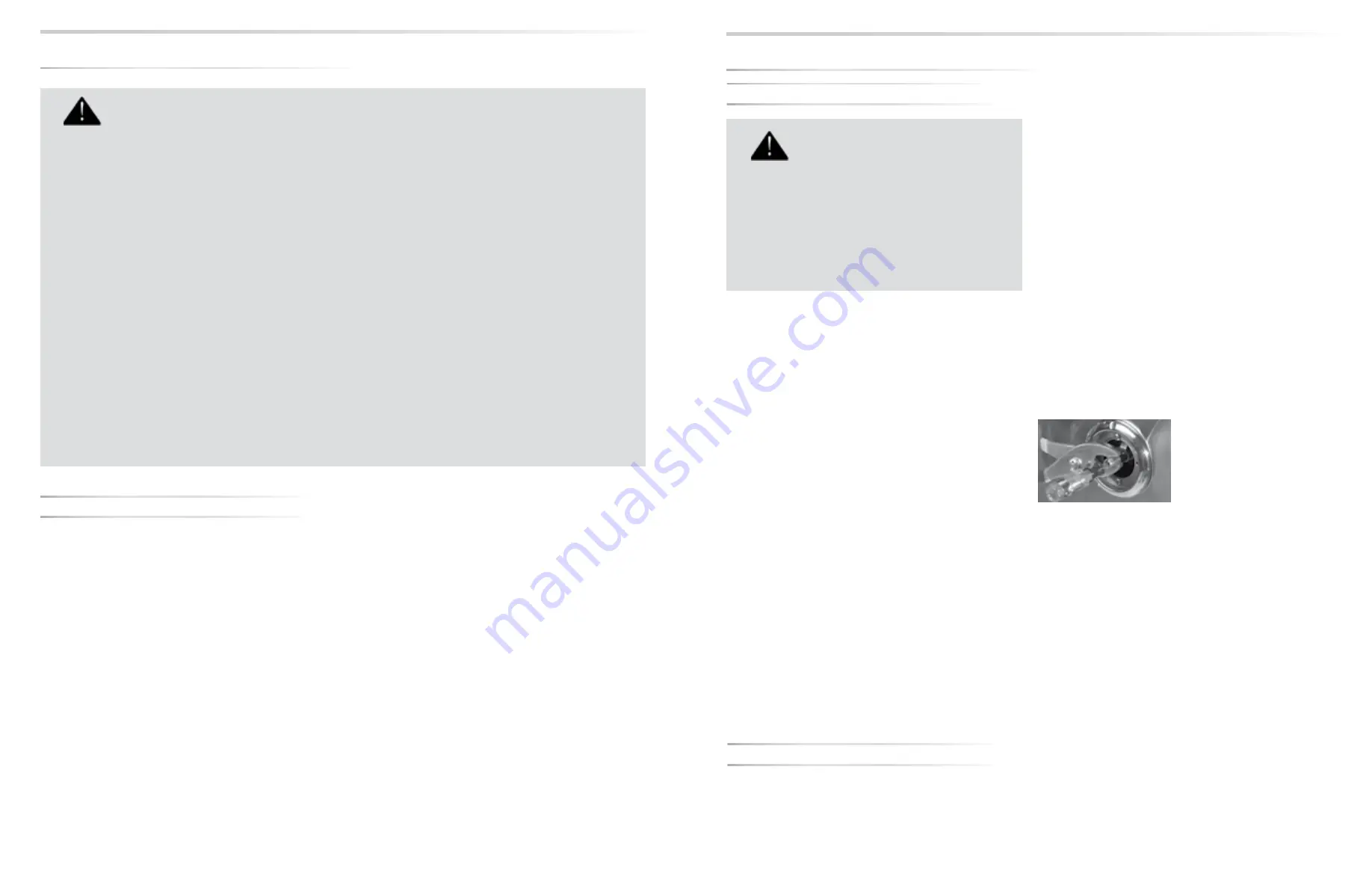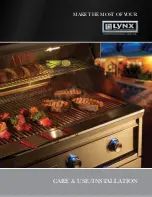
CARE & USE/INSTALLATION
|
18
19
|
CARE & USE/INSTALLATION
Installation requires an outdoor 120VAC 15A GFI (Ground
Fault Interrupter) electrical outlet adjacent to the grill.
The GFI outlet features an internal breaker that reduces
shock hazard. This type of outlet should be installed by a
qualified electrician either inside the island enclosure for
built-in units, or near the location where a free-standing unit
will be used.
For built-in grills, the supplied 12VDC should be installed
below the grill within the cabinet enclosure. Select a
location where the transformer is protected against water,
heat and physical damage.
When installing the transformer to the grill be careful to
prevent the wiring and transformer from contacting any
hot surfaces behind or below the grill. It is recommended
that the transformer be located below the grill in a readily
accessible location. Be sure to provide adequate access to
facilitate service if the transformer or connections should
need future maintenance.
If the electrical system fails to operate, a connection may
have come loose in shipping or the GFI may have tripped,
requiring a reset. See the Troubleshooting section for more
details.
CONNECTION TO AC
ELECTRICAL CONNECTIONS
• Product installation must meet local electric codes or, in the absence of local codes, the latest edition of the
National Electrical Code ANSI/NFPA No. 70 or the Canadian Electrical Code CGA 1.6b2005.
• Use only a Ground Fault Interrupter (GFI) protected circuit with this outdoor cooking gas appliance.
• IMPORTANT
: When connecting your rotisserie motor, first connect the motor to the grill and then plug the grill
into the outlet.
• This grill is equipped with a three prong (grounding) electric plug for your protection against shock hazard and
must be plugged directly into a properly grounded three prong outlet. Never cut or remove the grounding
prong from this plug.
• Use only extension cords with a 3 prong grounding plug, rated for the power of the equipment, and approved
for outdoor use with a “W-A” marking.
• To protect against electric shock, do not immerse any part of the power cord, an extension cord or any plugs in
water or other liquid.
• Unplug the product from the outlet when not in use and before cleaning. Allow it to cool before putting on or
taking off parts.
• Do not let the cord hang over the edge of a table or touch hot surfaces.
• Do not use an outdoor cooking gas appliance for purposes other than intended.
• Do not operate any outdoor cooking gas appliance with a damaged cord, plug, or after the appliance malfunc-
tions or has been damaged in any manner. Contact the manufacturer for repair.
WARNING: ELECTRICAL GROUNDING
FINAL CHECKS
LEAK TESTING
Leak Test Procedure:
• Create a soapy solution of 1 part soap and 3 parts water.
• Confirm that all control knobs are in the off position.
• Turn on the fuel supply. For natural gas, turn the valve
handle 1/4 turn to align with the gas flow.
• For L.P., turn the cylinder valve knob counter clockwise
one full rotation.
• Apply the soap solution generously by paint brush or
squirt bottle on all connections and fittings.
• If bubbles appear to “grow” on any of the connections,
you have a gas leak. IMMEDIATELY turn off the gas
supply.
Fixing a Gas Leak:
• Shut off the gas supply
• Turn all grill controls to the “ON” position to purge the
grill of any gas build-up, then turn the controls back
“OFF”.
• Wash off the soapy solution with cold water and dry.
• Tighten the loose joint, or replace the faulty part with
manufacturer-recommended replacement parts.
• DO NOT attempt to repair the L.P. cylinder valve if it is
damaged. The only way to safely resolve a damaged
cylinder is to REPLACE IT.
• Repeat the leak test to ensure that no leaks are present.
LOW HEAT BURNER ADJUSTMENT
FOR MAIN CERAMIC AND TRIDENT ™ BURNERS ONLY!
DO NOT ADJUST THE ROTISSERIE BURNER.
The main ceramic burners and Trident ™ burner on your
Lynx grill feature an adjustable low setting.
Fluctuations in gas pressure, gas conversion and even in the
quality of the gas itself may affect burner performance at the
“LOW” setting. It could be either too high or too low.
To Adjust the Burner to a Low Setting:
• Make sure the grill is cool.
• Remove the racks so you can see the flames while
adjusting the burners.
• Light the burner and allow it to preheat on high for 3
minutes.
• Turn the burner to “LOW”.
• Pull off the control knob.
• While holding the valve shaft with pliers as shown insert a
small flat screwdriver into the center shaft and adjust the
flame’s low setting. (1/8” blade 3” long shaft)
Clockwise will lower the flame setting, counterclockwise will
raise it.
The proper setting is where the flame is stable at its
lowest setting. On the Trident™ burner slight flutter will be
present in the crossover portion of the front of the burner
before the burner itself becomes weak.
The factory setting for propane gas is ½ to ¾ turn from the
very bottom of the adjustment. The setting for natural gas
is 1-½ to 1-¾ from the bottom. After the low settings are
proper, turn all burners to high for visual inspection.
To prevent fire or explosion hazard, DO NOT
smoke or allow any potential source of ignition
(sparks, electrical arcing, etc) in the area while
performing a leak test. Leak tests should be
conducted outdoors only. Never conduct a leak
test using fire or flame.
DANGER!











































